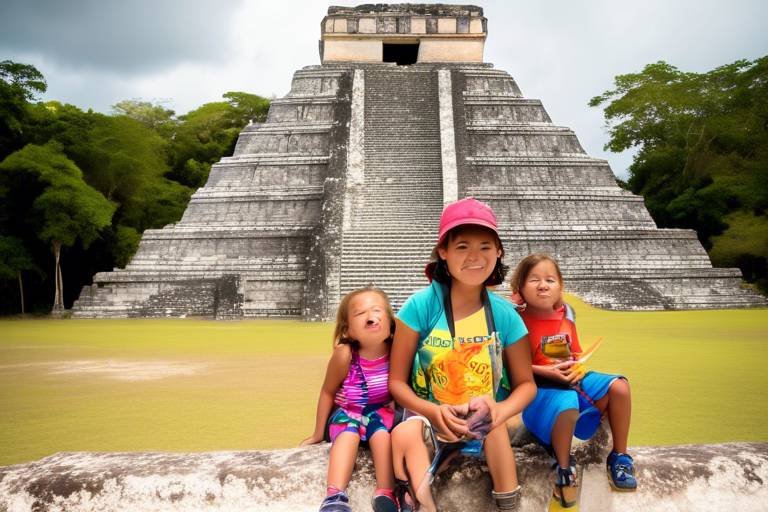Teaching Kids to Appreciate Art on a Trip to Madrid
When you think about a family trip to Madrid, the vibrant streets filled with history, culture, and, of course, art come to mind. But how do you make sure that your kids not only enjoy the experience but also learn to appreciate the beauty of art? It’s all about creating an engaging atmosphere that sparks their curiosity and imagination. By immersing them in the artistic wonders of this magnificent city, you’re not just filling their heads with knowledge; you’re planting the seeds for a lifelong love of creativity. Imagine walking through the grand halls of the Prado Museum, where the masterpieces of Velázquez and Goya come alive, or exploring the modern expressions at the Reina Sofia Museum, where Picasso and Dalí challenge their perceptions and emotions. The goal is to transform art from something that seems distant and unapproachable into a world that feels relevant and exciting. So, how can you make this happen during your Madrid adventure? Let's dive into the importance of art education and discover some must-visit art museums that will make your trip unforgettable.
Art education plays a crucial role in childhood development. It’s not just about learning to paint or draw; it’s about nurturing creativity, enhancing critical thinking, and fostering emotional expression. When children engage with art, they learn to observe the world around them from different perspectives. This experience can be transformative, as it encourages them to think outside the box and express their feelings in unique ways. Think of art as a language that transcends words; it allows kids to communicate their thoughts and emotions without saying a single word. By introducing your children to art at a young age, you are giving them a powerful tool that they can use throughout their lives.
Madrid is a treasure trove of art museums, each offering a unique glimpse into different artistic styles and periods. Visiting these institutions can provide children with firsthand experiences that ignite their imaginations. Here are some must-visit art museums that are sure to captivate young minds:
The Prado Museum is one of the most famous art museums in the world, housing an extensive collection of European art that spans several centuries. As you walk through its grand halls, your kids can learn about iconic artists like Velázquez and Goya. Imagine the thrill of seeing Las Meninas in person! This museum isn’t just about looking at paintings; it’s about exploring the rich history and significance behind each piece. To make the experience even more engaging, many museums offer interactive tours specifically designed for kids. These tours make art accessible and enjoyable, encouraging children to ask questions and engage with the artwork in a meaningful way.
Interactive tours can transform a traditional museum visit into an exciting adventure. These tours often include hands-on activities, storytelling, and games that help kids connect with the art on display. For instance, imagine your child stepping into the shoes of a famous artist as they learn about the techniques used to create stunning masterpieces. This kind of immersive experience can make art feel alive and relevant, sparking a genuine interest in creativity.
Another fantastic way to engage children with art is through family-friendly workshops. These workshops allow kids to create their own art inspired by the masterpieces they see. Whether it’s painting, sculpting, or even digital art, these hands-on experiences can deepen their appreciation for artistic expression. Plus, it’s a great way for families to bond while exploring their creative sides together. Just think of the joy on your child’s face as they proudly display their artwork, inspired by the greats!
Next on your Madrid art adventure should be the Reina Sofia Museum, which focuses on modern and contemporary art. Here, children can explore iconic works by Picasso and Dalí, sparking discussions about artistic movements and the emotions behind the art. The museum’s collection challenges conventional ideas of beauty and encourages kids to think critically about what they see. Imagine the conversations you can have as you walk through the exhibits, discussing how art can evoke different feelings and interpretations.
As you embark on this artistic journey, here are some effective strategies to enhance your children's engagement with art:
Visual storytelling can captivate children’s imaginations. By sharing the stories behind the artwork, you help them connect emotionally and understand the context of the pieces they encounter. For example, instead of just pointing out a painting, tell them about the artist’s life, the time period, or the emotions that inspired the piece. This narrative approach can make the artwork come alive in their minds.
Encouraging children to ask questions fosters curiosity and critical thinking. Engage them in discussions about what they see, asking them open-ended questions like, “What do you think the artist was feeling when they created this?” or “How does this piece make you feel?” These conversations can lead to deeper insights and a greater appreciation for art, turning each museum visit into an enriching experience.
Q: What age is appropriate to start introducing kids to art?
A: It's never too early! Even toddlers can enjoy colors and textures. As they grow, you can introduce them to more complex concepts and art styles.
Q: Are there any special programs for kids at the museums?
A: Yes! Many museums in Madrid offer family-friendly workshops, interactive tours, and educational programs specifically designed for children.
Q: How can I make art more relatable for my kids?
A: Use stories, analogies, and relatable examples to connect the art to their lives. Discuss emotions and thoughts the art evokes to make it more personal.

The Importance of Art Education
Art education plays a crucial role in the development of children, acting as a gateway to creativity, critical thinking, and emotional expression. Imagine a world where children can express their feelings through colors, shapes, and textures—this is the magic that art brings into their lives. Art education not only nurtures their creative instincts but also enhances their cognitive abilities. Research has shown that children who engage in artistic activities tend to perform better academically, as they learn to think outside the box and approach problems from various angles.
Furthermore, art education fosters emotional intelligence. When children create or analyze art, they learn to express their emotions and understand those of others. This can lead to improved empathy and social skills, which are essential in today’s interconnected world. It’s like giving them a toolkit for navigating their feelings and relationships. By engaging with art, children can learn to articulate their thoughts and emotions, making them more self-aware and confident individuals.
Additionally, art education encourages cultural awareness. Through exploring different artistic styles and movements, children gain insights into diverse cultures and histories. This exposure helps them appreciate the beauty of diversity and understand the world around them better. For instance, when they learn about African masks or Japanese ink paintings, they are not just observing art; they are stepping into the shoes of different communities and traditions.
Incorporating art into education can also ignite a lifelong passion for creativity. Think of art as a seed planted in a child’s mind; with the right nurturing, it can grow into a flourishing garden of imagination and innovation. When children are exposed to art at a young age, they are more likely to seek out creative outlets as they grow, whether that be through painting, music, dance, or even writing. This lifelong appreciation for creativity can lead to fulfilling careers and hobbies that enrich their lives.
In conclusion, the importance of art education cannot be overstated. It is a multifaceted approach that enriches children’s lives by enhancing their creativity, emotional intelligence, and cultural understanding. As parents and educators, it’s vital to recognize and promote the value of art in childhood development, ensuring that the next generation is equipped with the tools they need to thrive in a complex world.

Must-Visit Art Museums in Madrid
When it comes to immersing children in the world of art, Madrid is like a treasure chest waiting to be explored. The city is home to several world-renowned art museums that not only showcase stunning works of art but also offer unique experiences that can ignite a passion for creativity in young minds. Imagine walking through halls adorned with vibrant paintings and sculptures, where each piece tells a story and invites curiosity. For families visiting Madrid, these museums are not just destinations; they are gateways to understanding culture, history, and the beauty of human expression.
The Prado Museum stands out as one of the crown jewels of Madrid's art scene. With its extensive collection of European masterpieces, the Prado provides an incredible opportunity for children to learn about iconic artists like Diego Velázquez and Francisco Goya. Walking through the museum, kids can see the famous painting "Las Meninas" and ponder what the artist was trying to convey. The museum’s rich history and significance can be captivating for children, especially when parents take the time to share interesting anecdotes about the artists and their works.
Another must-visit is the Reina Sofia Museum, which focuses on modern and contemporary art. Here, children can encounter the powerful works of Pablo Picasso and Salvador Dalí. For instance, seeing Picasso's "Guernica" can spark discussions about the emotions and historical context behind the painting, making it more relatable and understandable for young viewers. The Reina Sofia often features temporary exhibitions that explore various themes, providing fresh content that can keep children engaged and excited about art.
To make the experience even more enriching, many of these museums offer interactive tours designed specifically for kids. These tours transform a typical museum visit into an adventure, where children can participate in activities, solve puzzles related to the artworks, and even engage in storytelling sessions that bring the art to life. For example, at the Prado, kids might be challenged to find specific details in a painting or guess the emotions of characters depicted in the artwork. This interactive approach not only makes art more accessible but also encourages children to ask questions and dive deeper into their understanding of the pieces they encounter.
Additionally, family-friendly workshops are often available at these museums, allowing children to unleash their creativity. Imagine your child being inspired by a beautiful painting and then getting the chance to create their own masterpiece! These hands-on experiences can deepen their appreciation for artistic expression and help them understand the creative process. Whether it's painting, drawing, or crafting, these workshops provide a fun and engaging way for kids to connect with art.
In conclusion, visiting the art museums in Madrid can be a thrilling and educational experience for children. By exposing them to the beauty of art and the stories behind it, parents can foster a lifelong appreciation for creativity. So, pack your bags, grab your little artists, and get ready to explore the vibrant art scene of Madrid!
- What is the best time to visit art museums in Madrid? It's best to visit during weekdays to avoid large crowds, and early mornings are typically quieter.
- Are there any discounts for children at these museums? Yes, many museums offer free entry for children under a certain age, and family tickets may be available at discounted rates.
- Can we take photographs inside the museums? Photography policies vary by museum, so it's best to check their rules before your visit.
- Do museums in Madrid offer guided tours for families? Absolutely! Many museums provide family-oriented guided tours that are engaging and informative.

The Prado Museum
The Prado Museum, or Museo del Prado, is not just a building filled with paintings; it's a treasure trove of European art that captivates the imagination of visitors young and old. Located in the heart of Madrid, this museum showcases an extensive collection that spans centuries, featuring masterpieces from renowned artists like Diego Velázquez, Francisco Goya, and Hieronymus Bosch. Imagine walking through grand halls where each painting tells a story, where colors and brushstrokes dance together to create a visual symphony. For kids, this experience can be nothing short of magical. It’s like stepping into a storybook where every page is a new adventure waiting to be discovered.
As you explore the Prado, you'll find that it's not just about looking at art; it's about experiencing it. Kids can learn about famous works such as Velázquez's "Las Meninas," a painting that sparks curiosity and questions. Why is the artist in the painting? Who are the people depicted? These questions can lead to fascinating discussions that enhance their understanding and appreciation of art. The museum also offers a variety of educational programs tailored specifically for children, making it easier for them to engage with the artwork.
For families visiting the Prado, there are several interactive tours designed to make the experience both fun and educational. These tours often include storytelling elements that capture the attention of younger audiences. Imagine a guide narrating the history behind a painting, weaving in tales of the artist's life and the era in which they lived. This not only makes the art more relatable but also stimulates children's imaginations, allowing them to envision themselves in the past.
Additionally, the museum hosts family-friendly workshops where kids can unleash their creativity. These workshops provide an opportunity for children to create their own art inspired by the masterpieces they’ve seen. It's a fantastic way for them to express their emotions and thoughts through their own artwork, fostering a deeper connection to the creative process. After all, art is not just something to be observed; it's something to be felt and created.
In summary, the Prado Museum is a must-visit destination for families looking to introduce their children to the world of art. With its rich collection, engaging programs, and interactive experiences, it serves as a gateway for kids to appreciate the beauty and significance of artistic expression. So, as you plan your trip to Madrid, make sure the Prado is high on your list of places to explore. Who knows? You might just inspire the next great artist!

Interactive Tours for Kids
When it comes to engaging children with art, interactive tours are a game changer! Imagine walking through the halls of a magnificent museum, where every painting tells a story, and every sculpture has a secret waiting to be uncovered. These specially designed tours for kids transform the traditional museum experience into an exciting adventure. Instead of just looking at art, children get to explore, interact, and even participate in the storytelling process.
Many museums in Madrid, like the Prado Museum and the Reina Sofia Museum, offer interactive tours that are both educational and fun. Kids can dive into the world of art through engaging activities such as scavenger hunts, where they search for specific pieces while learning fascinating facts about each one. This not only keeps them entertained but also sparks their curiosity about the artists and the stories behind their creations.
During these tours, children might find themselves in front of a famous painting, and instead of just admiring it, they are encouraged to think critically. Questions like, “What do you think the artist was feeling when they created this?” or “Why do you think the colors are so vibrant?” open up a dialogue that allows kids to express their thoughts and feelings. This kind of engagement helps them develop a deeper connection to the art and enhances their understanding of different artistic styles.
Furthermore, many interactive tours incorporate technology, using apps or augmented reality to bring the artwork to life. Imagine a child pointing a tablet at a painting and seeing it animate or hearing the artist's voice explain their work! This fusion of technology and art not only captivates their attention but also makes learning about art feel like an exciting quest rather than a chore.
To give you a clearer picture of what these tours might look like, here’s a quick comparison of some interactive offerings in Madrid:
| Museum | Interactive Tour Features | Recommended Age Group |
|---|---|---|
| Prado Museum | Scavenger hunts, storytelling sessions | 6-12 years |
| Reina Sofia Museum | Augmented reality experiences, interactive workshops | 8-14 years |
| Thyssen-Bornemisza Museum | Art detective games, family guides | 5-10 years |
These interactive experiences not only make art more accessible but also encourage children to express their creativity. By participating in hands-on activities, they can create their own art inspired by what they see. This not only deepens their appreciation for artistic expression but also allows them to take home a piece of their adventure, whether it’s a drawing, a painting, or a fun memory to share with friends and family.
In conclusion, interactive tours are an excellent way to engage kids with art. They transform a museum visit into an immersive experience that fosters curiosity, creativity, and a lifelong love for the arts. So, the next time you're in Madrid, don’t miss out on these fantastic opportunities to make art come alive for your children!
- What age is suitable for interactive tours? Most interactive tours cater to children aged 5-14, with specific activities designed for different age groups.
- Do I need to book in advance? It’s recommended to book in advance, especially during peak tourist seasons, to ensure availability.
- Are there any costs associated with these tours? Some interactive tours may have additional fees, but many museums offer free or discounted rates for children.
- Can parents join the interactive tours? Absolutely! Parents are encouraged to participate and engage with their children during these tours.

Family-Friendly Workshops
When it comes to making art accessible and enjoyable for children, are a fantastic way to engage young minds. These workshops are designed to be interactive, allowing kids to not only observe art but also to create their own masterpieces inspired by what they see. Imagine your child stepping into a vibrant studio filled with colors, brushes, and canvases, ready to unleash their creativity! It's an experience that can ignite a passion for art that lasts a lifetime.
Many of Madrid's museums, such as the Prado Museum and the Reina Sofia Museum, offer specialized workshops tailored for families. These sessions often include guided tours where children are introduced to famous works before diving into hands-on activities. During these workshops, children might learn about different art techniques, explore various materials, and even get tips on how to express their emotions through art. This combination of learning and creating not only enhances their understanding of artistic expression but also fosters a sense of accomplishment.
Furthermore, workshops often cater to various age groups, ensuring that every child, from toddlers to pre-teens, can participate and enjoy the experience. Here’s a glimpse of what you might find in these workshops:
| Age Group | Workshop Theme | Duration |
|---|---|---|
| 3-5 years | Color Exploration | 1 hour |
| 6-8 years | Introduction to Famous Artists | 2 hours |
| 9-12 years | Mixed Media Masterpieces | 3 hours |
These workshops are not just about creating art; they’re about building confidence and encouraging self-expression. Kids learn to appreciate the process of making art, rather than just the final product. They experiment with different styles, and techniques, and even collaborate with peers, which fosters teamwork and social skills. It’s like giving them a key to unlock their imagination!
Moreover, participating in these workshops often leaves children with tangible keepsakes—art pieces they can be proud of and share with friends and family. This sense of ownership can be incredibly empowering, reinforcing their love for art and creativity. So, if you’re planning a trip to Madrid, be sure to check out the schedule of family-friendly workshops at the museums. Your kids will thank you for it, and you might just find yourself inspired too!
- What age groups are suitable for family-friendly workshops?
Workshops typically cater to a range of ages, often from toddlers to pre-teens, with activities tailored to different developmental stages. - Do we need to book workshops in advance?
It's advisable to book in advance, as these workshops can fill up quickly, especially during peak tourist seasons. - Are materials provided during the workshops?
Yes, most workshops provide all necessary materials, so you and your child just need to bring your creativity! - Can parents participate in the workshops?
Absolutely! Many workshops encourage parents to join in the fun, making it a great bonding experience.

The Reina Sofia Museum
The Reina Sofia Museum, a gem nestled in the heart of Madrid, is a treasure trove of modern and contemporary art that can ignite the creative spark in children. Imagine walking through a vibrant maze of colors and forms, where every corner reveals a new story waiting to be told. This museum is not just about looking at art; it’s about feeling it, understanding it, and connecting with the emotions behind each piece. Kids can dive into the fascinating world of artists like Pablo Picasso and Salvador Dalí, whose works often provoke thought and discussion. For instance, Picasso’s iconic Guernica isn’t just a painting; it’s a powerful statement about war and peace that can lead to meaningful conversations with your little ones.
As you stroll through the museum, you’ll notice that the Reina Sofia isn’t just a place for passive observation; it actively invites engagement. With its innovative exhibits and interactive displays, children can explore the emotions and stories behind the art. For example, the museum often features workshops and guided tours specifically designed for younger audiences, making the experience both educational and fun. These workshops allow children to create their own masterpieces, inspired by the greats they’ve just seen. It’s a wonderful way for them to express their own creativity while learning about different artistic styles and techniques.
Moreover, the architecture of the museum itself is a work of art. The blend of the old and the new, with the stunning glass and metal structure of the Nouvel Building juxtaposed against the historical General Hospital of Madrid, provides a visual feast that can captivate children’s imaginations. Walking through the museum can feel like stepping into a living canvas, where every angle offers a new perspective. Encourage your kids to take a moment to appreciate not just the art on the walls, but the art of the building around them. It’s a reminder that creativity can be found in many forms, and it’s all around us.
In addition to the visual delights, the Reina Sofia Museum often hosts temporary exhibitions that showcase a range of artistic movements, from surrealism to abstract expressionism. This dynamic environment means that each visit can offer something new and exciting, keeping children engaged and eager to return. By exposing them to different styles and ideas, you’re not just teaching them about art; you’re encouraging them to think critically and appreciate the diversity of human expression.
In conclusion, a trip to the Reina Sofia Museum can be an unforgettable experience for children, enriching their understanding of art while allowing them to explore their own creativity. So, whether they’re creating their own artwork in a workshop or simply marveling at a Picasso, they’re sure to leave with a greater appreciation for the beauty of art and its power to communicate emotions and ideas.
- What age is appropriate for visiting the Reina Sofia Museum?
Children of all ages can enjoy the museum, but interactive tours and workshops are often tailored for ages 5 and up.
- Are there family discounts available for museum entry?
Yes, the Reina Sofia Museum often offers family tickets at a reduced rate, making it more affordable for families to explore together.
- Can we take photos inside the museum?
Photography is allowed in most areas, but be sure to check for specific restrictions in certain exhibitions.

Tips for Engaging Kids with Art
Engaging kids with art can sometimes feel like trying to teach a cat to swim—challenging but not impossible! The key lies in making the experience enjoyable and relatable. First off, visual storytelling is an incredible way to capture their attention. When you share the stories behind the artworks—like the dramatic life of Van Gogh or the surreal world of Salvador Dalí—it transforms a simple painting into a narrative adventure. Kids love stories, and when they see art as a part of a larger tale, it becomes much more engaging.
Another effective strategy is to encourage questions and discussions. Kids are naturally curious, and by inviting them to ask questions, you foster an environment of exploration. For instance, if they see a piece that intrigues them, ask, "What do you think the artist was feeling when they created this?" This not only stimulates their critical thinking but also helps them connect emotionally with the art. You might be surprised by the depth of their insights!
Additionally, consider incorporating hands-on experiences. Many museums offer workshops where children can create their own art inspired by what they've seen. This practical approach not only reinforces their learning but also allows them to express their creativity. Imagine your child standing in front of a Picasso, then rushing to a workshop to create their own version of a cubist masterpiece! It’s a full-circle moment that deepens their appreciation for artistic expression.
Don't forget the power of interactive technology. Many modern museums have digital displays or apps that offer augmented reality experiences. Kids can point their devices at a painting and see it come to life or learn fun facts about the artist and the artwork. This tech-savvy approach not only captivates them but also makes learning about art feel like an exciting game.
Lastly, make sure to connect art to their everyday lives. Talk about how art influences the world around them—from the design of their favorite toys to the illustrations in their books. By relating art to their interests, you’ll help them understand its relevance and importance. When kids see art as a part of their lives, they’re more likely to appreciate it in a museum setting.
Q: How can I prepare my kids for a museum visit?
A: Before the visit, talk to them about what they might see. You can look up some famous artworks together, or even watch short videos about the artists. This will build excitement and give them a context for what they’ll experience.
Q: Are there specific museums in Madrid that are more kid-friendly?
A: Yes! The Prado and Reina Sofia both offer family-friendly programs and workshops. These museums are designed to engage children through interactive tours and creative activities.
Q: What if my child loses interest during the visit?
A: That's normal! Keep the experience fun by taking breaks and discussing what they like or dislike about the art. You can also play games, like finding specific colors or shapes in the artworks, to keep their attention.
Q: How can I encourage my child to express their feelings about the art?
A: Encourage them to use descriptive words to talk about what they see. Ask guiding questions like, "What does this piece make you feel?" or "If you could add something to this artwork, what would it be?" This helps them articulate their thoughts and feelings.

Use Visual Storytelling
When it comes to capturing the interest of children, visual storytelling is a powerful tool that can transform a mundane museum visit into an extraordinary adventure. Imagine walking through the halls of a museum, surrounded by vibrant paintings and captivating sculptures, and weaving a narrative around each piece. This approach not only enhances their understanding of the art but also ignites their imagination. Just like a good book, every artwork has a story waiting to be discovered.
For instance, when standing in front of a painting by Picasso, you might share a tale about the artist's life, the emotions he experienced, or the historical context that inspired his work. By creating a relatable narrative, you can help children visualize the scene and feel a connection to the artist's intentions. This method encourages them to look beyond the canvas and appreciate the deeper meanings embedded within the art.
Moreover, you can make the experience even more interactive by asking questions that prompt them to think critically. Questions like "What do you think the artist was feeling when they created this?" or "How does this piece make you feel?" can lead to engaging discussions that allow children to express their thoughts and emotions freely. By fostering a dialogue, you not only validate their opinions but also encourage them to develop their own interpretations of the artwork.
To enhance this experience, consider incorporating some of the following storytelling techniques:
- Character Creation: Encourage kids to imagine characters within the artwork. Who are they? What are their stories?
- Setting the Scene: Describe the environment depicted in the art. What sounds, smells, or feelings would be present?
- Plot Twists: Suggest alternative endings or scenarios based on the artwork. How would the story change?
By using these techniques, you can turn a simple museum visit into a captivating narrative journey. This not only makes art more relatable but also fosters a sense of curiosity and wonder in children. Remember, the goal is to make art accessible and enjoyable, sparking a lifelong appreciation for creativity.

Encourage Questions and Discussions
When it comes to appreciating art, one of the most powerful tools we have at our disposal is the ability to encourage questions and discussions. Imagine walking through a museum, surrounded by vibrant paintings and striking sculptures, and instead of simply observing, your child is actively engaging with the art. This not only makes the experience more enjoyable but also enriches their understanding and appreciation of creativity. By fostering an environment where questions are welcomed, you open the door to a world of curiosity and exploration.
Asking questions can transform a simple museum visit into a profound learning experience. For instance, instead of just pointing out colors or shapes, encourage your child to ponder why the artist chose a particular style or subject. Questions like, “What do you think the artist was feeling when they created this?” or “How does this painting make you feel?” can lead to deeper insights. It’s like diving into a treasure chest of emotions and thoughts, where every piece of art tells a story waiting to be uncovered.
Moreover, discussions about art can help children develop critical thinking skills. When they articulate their thoughts and feelings about what they see, they practice expressing themselves and defending their opinions. This is akin to a mini-debate, where they learn to respect different viewpoints while also forming their own. You might find that a simple painting sparks a conversation about history, culture, or even personal experiences, making art a bridge to broader topics.
To facilitate these discussions, consider using the following strategies:
- Be Curious Together: Show enthusiasm for the artwork and express your own questions. This models the behavior you want to see in your child.
- Share Stories: Talk about the artists, the time periods, or the techniques used in the artwork. These narratives can captivate young minds and make the art more relatable.
- Connect to Their Interests: Relate the art to things your child already loves, whether it's a favorite movie, a hobby, or even a personal experience. This connection can make the art feel more relevant and exciting.
By creating a dialogue around art, you not only enhance your child's museum experience but also help them develop a lifelong appreciation for creativity. After all, art is not just about what we see; it's about the stories we tell and the emotions we share. So, the next time you visit a museum, remember to ask questions and encourage discussions. You might be surprised at the insights and connections your child will make, turning a simple trip into an unforgettable journey of discovery.
Here are some common questions parents might have about engaging their kids with art during museum visits:
- How do I start a conversation about art with my child? Begin with simple observations and encourage them to share their thoughts and feelings.
- What if my child doesn't seem interested in art? Try to connect art to their interests or use interactive activities to spark their curiosity.
- Are there specific questions I should ask? Yes! Questions about feelings, colors, and the story behind the artwork can be great starters.
Frequently Asked Questions
- What are the best art museums to visit in Madrid with kids?
Madrid boasts several incredible art museums perfect for kids. The Prado Museum is a must-visit, showcasing European masterpieces that can spark children's imaginations. The Reina Sofia Museum is another fantastic option, focusing on modern art, including works by Picasso that can lead to exciting discussions about artistic expression.
- How can I make art museums more engaging for my children?
To keep your kids engaged during museum visits, consider taking advantage of interactive tours and family-friendly workshops. These experiences allow children to participate actively, making art more accessible and enjoyable. Additionally, using visual storytelling to share the stories behind the artwork can captivate their imaginations and encourage them to ask questions.
- Are there any workshops specifically designed for kids?
Yes! Many museums in Madrid offer family-friendly workshops where kids can create their own art inspired by the masterpieces they see. These hands-on experiences not only enhance their appreciation for art but also allow them to express their creativity in a fun and engaging environment.
- How can I encourage my child to ask questions about art?
Encouraging questions can be as simple as prompting your child with open-ended inquiries, like “What do you think this painting is about?” or “How does this piece make you feel?” Engaging them in discussions about the art they see helps foster their curiosity and critical thinking, leading to a deeper appreciation for the creative process.
- What age is appropriate for children to start appreciating art?
There's no specific age to start appreciating art; children can begin to engage with art from a very young age! The key is to introduce them to art in a fun and interactive way, allowing them to explore and express their thoughts freely. As they grow older, their understanding and appreciation will naturally deepen.



















